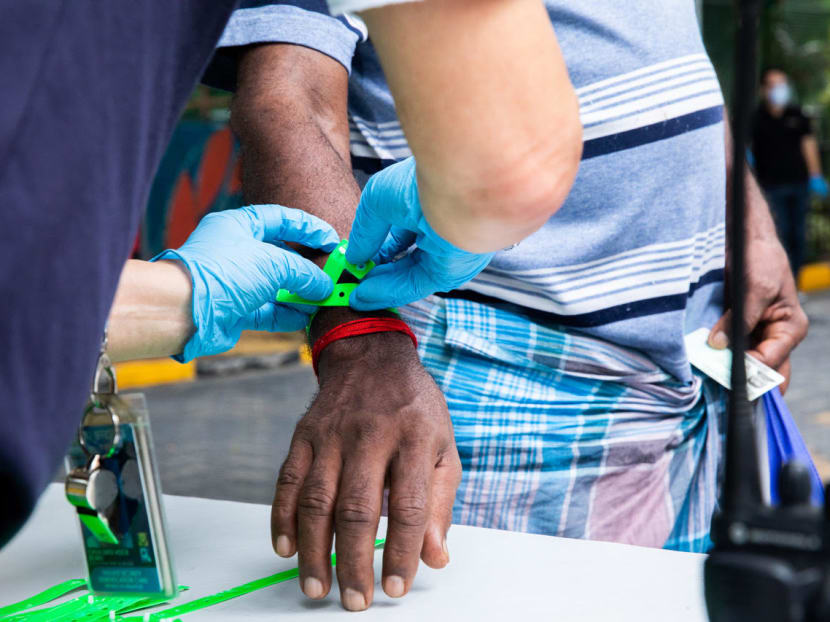New Covid-19 cases in cleared dorms weren’t picked up by earlier tests as virus was incubating: Task force
SINGAPORE — New infections surfacing at foreign worker dormitories already cleared of Covid-19 were not because they went undetected due to inaccurate Covid-19 tests, but because of the incubation cycle of the coronavirus.

Even though foreign worker dormitories in Singapore were declared cleared of Covid-19 infections in August 2020, the Ministry of Health said that there have been about 45 new cases daily.
- PCR tests for Covid-19 gives a “snapshot” of a migrant worker at the particular point in time
- Due to the incubation cycle of the virus, it may not be present in sufficient quantities to be detected when test was done
- Some dormitory residents were also asymptomatic and were not detected
- To detect and contain new cases, MOM has several measures that dormitory operators and residents have to follow
- The Government is looking into doing a “predictive study” on selected dormitories with the aid of TraceTogether tokens
SINGAPORE — New infections surfacing at foreign worker dormitories already cleared of Covid-19 were not because they went undetected due to inaccurate Covid-19 tests, but because of the incubation cycle of the coronavirus.
Dr Tan See Leng, Second Minister for Manpower, said this on Wednesday (Sept 9) at a virtual press conference by the governmental task force handling the Covid-19 pandemic.
Even though foreign worker dormitories in Singapore were declared cleared of Covid-19 infections last month, the Ministry of Health (MOH) said that there have been about 45 new cases daily.
About 2 per cent of these cases have positive serological tests, which indicate past infections, the ministry said in a news release on Wednesday.
A question was asked at the press conference on whether cases at the dormitories might have slipped through the cracks when they were declared cleared of Covid-19 on Aug 11.
There was also the question of whether the polymerase chain reaction (PCR) tests used to detect the virus are 100 per cent accurate.
Dr Tan, who is also the Second Minister for Trade and Industry, explained that a PCR test provides a “snapshot” of the migrant worker at a particular point in time.
“It's just that at that particular point in time in the cycle of the incubation, we may not have picked up the virus because... the concentration of (the virus) has still not reached (a detectable level) yet,” he said after assuring the media that the Covid-19 test kits are accurate.
Furthermore, there is a percentage of dormitory residents who were asymptomatic, which is also why the authorities were not able to detect the Covid-19 cases at that point of time.
“That's why we tighten the dragnet by implementing, back-to-back, this rostered routine testing,” he said of the ongoing fortnightly tests that employers of migrant workers have to schedule for them to do.
DETECTING AND CONTAINING NEW CASES
MOH said that the new Covid-19 cases at the cleared worker dormitories were primarily detected through active surveillance testing such as the rostered routine testing, and through aggressive tracing and testing whenever a new case is detected.
The dormitory residents who have never been infected remain susceptible to the coronavirus, MOH said.
To keep cases in the dormitories under control, MOH said that the Ministry of Manpower (MOM) has put in place a “multi-layered strategy” that will allow it to detect and contain any new infections.
This includes measures to prevent the formation and spread of large clusters.
For instance, before dormitory residents are allowed to return to work, the dormitory operators have to have various physical distancing measures to limit inter-mixing of residents across rooms, levels and blocks, as well as when using common facilities and during transport to and from worksites.
They must also monitor their residents’ health and take necessary precautions, so that residents who are unwell are quickly isolated and given medical treatment.
To speed up the detection of new cases of infection, MOM will require migrant workers to regularly keep track of their own health status.
It will also be keeping a close eye on workers who report sick at medical posts with acute respiratory illnesses, conducting wastewater testing at selected dormitories for traces of the virus, and carrying rostered routine testing for dormitory residents every two weeks.
In the event that a new case is detected, MOH said that close contacts of the affected individual will be quarantined and must test negative at the end of their quarantine period before they are able to return to work.
Aggressive testing operations will be carried out within the dormitories based on an assessment of the risk of potential spread, it added.
SIGNIFICANT MITIGATION OF TRANSMISSION RISKS
During the press conference, Dr Tan also responded to a question on whether there could be a risk of greater community spread with more dormitory residents heading out to work, and whether the authorities are reconsidering the gazetting of dormitories.
He said that it is thus important for dormitory residents to undergo rostered routine testing.
He also said that the authorities have “very, very stringent” safe distancing measures in the dormitories and has “tightly regulated” the transportation of migrant workers to their worksites.
Even within the worksites, the workers have very clear separation zones and safe distancing measures, he added. This means that they can only work at a section assigned to them.
“While we cannot completely eliminate the transmission risks, these risks have been mitigated significantly downwards,” Dr Tan said.
However, Minister for Health Gan Kim Yong noted during the press conference that there is still a risk to the community.
The nature of the worksite means that there will still be interaction, and it will not be limited to just migrant workers, but with Singaporeans working there as well.
"So there is risk," Mr Gan said.
"What is crucial really is to ensure that in addition to the measures that we have imposed at the dormitories and the worksites, we need to continue to be quite tight in the safe distancing measures in the community."
If this is done, even if there is an infection in the community, the authorities can reduce the risk of spread and lower the chances of a large community cluster forming, he added.
Dr Tan said that aside from the mitigation measures he mentioned, the authorities are looking into carrying out a “pre-emptive, predictive study” that will focus on selected dormitories with the aid of the TraceTogether tokens used for contact tracing.
This will allow the authorities to have a “heightened level of vigilance and surveillance” on the dormitories, he said.








